Publication Information
Frequency: Continuous
Format: PDF and HTML
Versions: Online (Open Access)
Year first Published: 2019
Language: English
| Journal Menu |
| Editorial Board |
| Reviewer Board |
| Articles |
| Open Access |
| Special Issue Proposals |
| Guidelines for Authors |
| Guidelines for Editors |
| Guidelines for Reviewers |
| Membership |
| Fee and Guidelines |
 |
Effects of planting date and crop age at harvest on cassava root and starch yield in the derived savanna of southwestern Nigeria
Ologunde O.H.ab, Busari M.A.a, Adebayo O.E.ab, Olowokere F.A.a, Kreye C.b, Salako F.K.a and Hauser S.b*
aDepartment of Soil Science and Land Management, Federal University of Agriculture, P.M.B. 2240, Abeokuta, Nigeria
bInternational Institute of Tropical Agriculture, P.M.B. 5320, Ibadan, Nigeria
Received Date: June 06, 2023; Accepted Date: June 16, 2023; Published Date: June 22, 2023;
*Corresponding author: Stefan Hauser, International Institute of Tropical Agriculture, P.M.B. 5320, Ibadan, Nigeria. Email: s.hauser@cgiar.org
Citation: Ologunde O.H, Busari M.A, Adebayo O.E, Olowokere F.A, Kreye C, et al. (2023) Effects of planting date and crop age at harvest on cassava root and starch yield in the derived savanna of southwestern Nigeria. Adv Agri Horti and Ento: AAHE-182.
DOI: 10.37722/AAHAE.2022403
Abstract
This study investigated the fresh root yield (FRY), root starch content (RSC) and root starch yield (RSY) response of two cassava varieties to different planting dates, different crop ages at harvest and the application of fertilizer. Cassava varieties, TME 419 and TMS 30572, were planted in April, June and August, and harvested at 9, 11 and 13 months after planting (MAP), without and with fertilizer application (75:20:90 kg ha-1 NPK). The trials were conducted at the Federal University of Agriculture, Abeokuta, Ogun state and at Psaltry International Limited, Ado-Awaye, Oyo state, both in south-western Nigeria. Increased cassava age at harvest significantly increased the FRY, RSC and RSY, in both locations. The planting dates had a less consistent effect: lowest FRY (11.19 Mg ha-1) and RSY (2.02 Mg ha-1) were attained when planted in April. The RSC was lowest when planted in June (17.5%), yet due to the highest FRY (13.11 Mg ha-1) the RSY (2.42 Mg ha-1) was higher than when planted in April. August planted cassava produced higher FRY (12.95 Mg ha-1) and RSC (21.7%), resulting in the highest RSY (2.966 Mg ha-1). Across locations, fertilizer application increased FRY, RSC and RSY, at all planting dates. The cassava varieties responded differently to the planting dates with TME 419 producing higher FRY (13.30 Mg ha-1), RSC (22.1%) and RSY (3.10 Mg ha-1) than TMS 30572 when planted in August. Our results show that delayed planting of cassava does not compromise root yields and provides opportunities for root supply all year round. Harvesting at 13 MAP attains higher cassava root yields and should be considered if the land is not required for other higher value crops.
Introduction
Cassava is an important staple food crop, widely cultivated in Sub-Saharan Africa as an affordable source of carbohydrates (Adiele et al., 2020). The roots are processed into different products for human consumption and animal feeds (Uchechukwu-Agua et al., 2015). Cassava provides approximately 285 calories per person per day for inhabitants in the developing countries (Benesi et al., 2004; Omodamiro et al., 2007). Cassava roots contain about 60-65% moisture and 25-30% starch (Tonukari, 2004) and attain higher starch yields than any other crop (Tonukari, 2004; Kaur et al., 2016).
Nigeria, the largest cassava producer in the world, almost doubled its production between 2000 and 2020 from 32 million tonnes to 60 million tonnes (FAOSTAT, 2020). This increase in root production was exclusively achieved by expanding the land area cultivated with cassava by over 130%, yet was accompanied by yield declines (FAOSTAT, 2020). At least 90% of the cassava produced in Nigeria is for local consumption (Denton et al., 2004; Ikuemonisan et al., 2020), yet the industrial demand is continuously growing. Cassava roots are raw material for the textile-, paper-, plywood-, adhesives-, bakery-, and pharmaceutical industries and to produce ethanol biofuel (Abotbina et al., 2022; Kolawole et al., 2010). To satisfy the growing demand for cassava roots, productivity increases are required and these should consequently lead to increased income generation from cassava for smallholders.
The performance of cassava is affected by the changes in environmental conditions, such as temperature, precipitation, soil moisture (Aina et al., 2007) and nutrient supply. Due to the changes in precipitation and available soil moisture during the growth of cassava, the plant devises adaptive mechanisms such as the reduction of leaf canopy and stomata closure (Santisopasri et al., 2001). These mechanisms are important for plant survival under water deficient conditions, although the photosynthetic activity and assimilate partitioning is negatively affected. A rapid recovery from water deficiency is usually accompanied by the formation of new leaves, green stems, and branches to increase the plant’s photosynthesis (CIAT, 1992). In a study conducted in Israel (Puangbut et al., 2015), it was reported that the seasonal effect of moisture changes is stronger than the effect of the year on the growth and yield of root and tuber crops.
Low soil fertility resulting from the continuous cultivation and low nutrient supply have been identified to limit crop productivity including cassava root yield (Chua et al., 2020; Pervaiz et al., 2020). However, cassava root yield responses to fertilizer application remain unreliable and further research on best fertilizer composition, quantities and application times are required to increase fresh root yields and starch production. Nevertheless, farmers grow cassava on poor soils because it is perceived to tolerate low nutrient availability (Kaluba et al., 2021). However, Parkes et al. (2012) and Santo and Sarkodie-Addo (2019) reported that the application of NPK fertilizer significantly increased the root starch content of different cassava varieties. Onasanya et al. (2021) found generally positive effects of fertilizer on fresh root yields in south-western Nigeria, while Enesi et al. (2022a) found such effects depending on location and planting date. Thus, further detailed research on optimum fertilizer composition, amounts and time of application is required for the range of planting dates and the large number of varieties.
In Southwest Nigeria, the cropping season starts between April and May, short after the beginning of the rainy season. As a result, most farmers prepare their fields and plant cassava during this period and the frequency of planting declines towards the end of the year. Harvesting of cassava usually falls within 12 to 18 months after planting, with improved varieties taking shorter periods (Charles et al., 2005). As a result, the seasonal rainfall pattern causes strong peak periods of cassava harvesting during certain periods of the year versus phases with low root supply (Alarcón and Dufour, 2012). The peak harvest season causes a glut of cassava roots and often unattractively low prices while shortages at other times of the year are accompanied by high prices. With a wider range of planting dates farmers could harvest in phases of low root supply and high prices, which would provide the opportunity of generating higher income, while providing roots to the industry and increasing their efficiency.
This study was carried out to test the following hypotheses: (1) Cassava root and starch yield are affected by the planting dates within a year, (2) cassava root and starch yields increase with increasing crop age at harvest, (3) fertilizer application increases cassava root and starch yields independent of planting date and crop age at harvest, (4) root and starch yield are independent of cassava variety and site.
Material and Methods
Site description
The study was conducted at the Directorate of University Farms (DUFARMS) of the Federal University of Agriculture, Abeokuta (FUNAAB), Ogun state (7° 14′ 21.49” N and 3° 26′ 51.12” E; 160.9 m above sea level) and the cassava farms of Psaltry International Limited (PSALTRY), Ado-Awaye, Oyo state (7° 47′ 36.96” N and 3° 23′ 55.72” E, 194.4 m above sea level), in the 2017-2018 cropping season. The FUNAAB study site is located within the forest-savannah transition zone (Salako et al., 2007). The soil is a sandy loam (685.4, 105.6 and 209.0 g kg-1 of sand, clay and silt, respectively) with a slightly gravelly sub surface. It is classified as Arenic Plinthic Kandiudalf in the USDA classification and Arenic Lixisol in the FAO/UNESCO classification system (Busari and Salako, 2012). The PSALTRY farms, in the Iseyin Local Government Area are in the Guinea savannah zone (Ayanlade et al., 2018) with loamy sand soil (840.3, 40.6 and 119.1 g kg-1 sand, clay and silt respectively), classified as Xanthic-Ferralic Arenosol in the FAO-UNESCO-ISRIC and Ferralic Brunic Arenosol in the WRB classification systems (Fagbami and Akinbola, 1995).
Experimental design
The trials were 4-factorial randomized complete block designs with three replicates. The first factor was the planting date (April, June and August 2017), the second factor was the crop age at harvest (9, 11 and 13 months after planting), the third factor were the cassava varieties (TME 419 and TMS 30572) and the fourth factor was fertilizer application at 2 levels (nil versus 75:20:90 kg ha-1 NPK). Thus, there were thirty-six treatment combinations. The inorganic fertilizer was applied at the rates of 75 kg N, 20 kg P, and 90 kg K per hectare as split application of 153.5 kg ha−1 NPK 15-15-15 at 4 and 8 weeks after planting, 63 kg ha−1 urea at 10 weeks after planting and 52 kg ha−1 MOP at 12 and 16 weeks after planting. The applications of urea and MOP fertilizer when planted in August were delayed until the onset of rainfall in the following year (2018) due to the start of the dry season in November 2017. Fertilizer was applied into semi-circle furrows dug around the cassava and then covered with soil.
Agronomic practices
The trial sites were double ploughed to a depth of 20 to 30 cm. Planting and harvest dates are listed in Table 1. Freshly cut TME 419 and TMS 30572 cassava stems (20 cm long each) were planted in a slanting position of about 45° at a spacing of 1 m × 0.8 m, to give a population of 12,500 plants ha-1. Each plot consisted of 49 cassava stands within an area of 39.2 m2 (7 m x 5.6 m). Cassava parameters were evaluated within the net plot of 20 m2 consisting of the inner 25 cassava plants. Primextra Gold, (active ingredients S-Metolachlor and Atrazine) was applied as pre-emergence herbicide immediately after planting at a rate of 4 L ha-1. Weeds were controlled manually by hoeing at 8 WAP and 16 WAP. At 24 WAP herbicide, Touch down® (active ingredient glyphosate) was applied at a rate of 3 L ha-1 with a spray shield to avoid herbicide touching the cassava green stems and leaves.
Cassava root yield determination
At each harvest the inner 25 plants of the net plot were harvested by manually uprooting the plants. The storage roots were cut off the planting stakes and separated into marketable (roots of > 2 cm diameter, without rot or deformations preventing effective peeling) and non-marketable roots. Marketable roots were cleaned of attached soil and counted and weighed. Non-marketable roots were not considered for the yield determination. The yield of the marketable roots was converted to Mg/ha with the formula:
 (1)
(1)
| Locations | Planting date | Harvest date at | ||
| 9 MAP | 11 MAP | 13 MAP | ||
| FUNAAB | April (12/04/2017) | 11/01/2018 | 12/03/2018 | 24/05/2018 |
| June (05/06/2017) | 15/03/2018 | 20/05/2018 | 11/07/2018 | |
| August (12/08/2017) | 18/05/2018 | 12/07/2018 | 15/08/2018 | |
| PSALTRY | April (17/04/2017) | 13/01/2018 | 18/03/2018 | 27/05/2018 |
| June (08/06/2017) | 17/03/2018 | 28/05/2018 | 14/07/2018 | |
| August (18/08/2017) | 29/01/2018 | 16/07/2018 | 17/08/2018 | |
Starch content and starch yield determination
The starch content of the fresh roots was determined by combining the specific gravity of fresh cassava roots with Von Scheele et al. (1937) equations. The specific gravity of fresh cassava roots was gravimetrically determined by comparing the root mass in air with the mass under water. A weighing net was suspended from a hanging balance. A vessel filled with water was placed below the weighing net. The mass of the empty net in air (Na) and under water (Nw) was determined. Three kg of clean marketable roots were placed in the net and weighed in the air (Ra). Thereafter the roots were completely immersed under water and the mass recorded (Rw). The specific gravity of the roots was calculated using the formula by Kleinkopf et al. (1987).
 (2)
(2)
Where Ra = Mass of roots in air, Rw = Mass of roots in water, Nw = Mass of empty net in water, Na = Mass of empty net in air.
The starch content was determined by Von Scheele et al. (1937) equations:
 (3)
(3)
The starch yield [Mg ha-1] was calculated by multiplying the starch content [%] with the fresh root yield [Mg ha-1] and divided by 100 (Knutsson, 2012).
Statistical analysis
All data were subjected to statistical analysis using R statistical software, version 4.2.0 (R Core Team, 2020). Analysis of variance (ANOVA) was computed to determine the response of fresh root yield, starch content, and starch yield to the treatments, using the linear mixed-effects model. Location, planting date, crop age at harvest, fertilizer application and variety were fitted as fixed factors while replications within location, planting date within replication and variety within planting date were fitted as random factors. This process was done using the lmer function in lme4 package (Bates et al., 2015). Post-hoc test was performed using the Tukey’s Honest Significant Difference (Tukey’s HSD) in the emmeans package (Lenth, 2022) for mean separation. Graphs were plotted with the ggplot2 package (Wickham, 2016).
Results
Weather conditions
The trial sites had a well-defined rainy season from March to October and a dry season from November to February. The total amount of rain (Table 2) received by the crops varied between the planting dates and crop ages at harvest. August planted cassava received less rain when harvested at 9 and 11 MAP than cassava planted in April. Differences were negligible when cassava was harvested at 13 MAP.
At FUNAAB, the daily maximum and minimum temperature in the dry season ranged from 31.9 to 35.8 °C and 27.5 to 33.4 °C, respectively, while they ranged from 31.6 to 33.7 °C and 27.3 to 32.8 °C, respectively, at Psaltry.
Location
Planting date
Crop age at harvest (months)
FUNAAB
9
11
13
April
1110
1154
1459
June
877
1122
1464
August
575
968
1487
Psaltry
April
945
1004
1164
June
746
915
1186
August
465
784
1191
Data source: CHIRPS, 2021
ANOVA and single factor effects
The analysis of variance (Table 3) revealed significant effects of the single factors planting date, crop age at harvest and fertilizer application on fresh root yield, starch content, and starch yield. Location affected fresh root yield and starch yield (Table 4). Significant factor effects and interactions were similar in fresh root yield and starch yield; starch content was less often affected.
Factor
Root yield (Mg ha-1)
Starch content (%)
Starch yield (Mg ha-1)
Location
0.00 ***
0.86
0.00 ***
Planting date
0.00 ***
0.00 ***
0.00 ***
Crop age
0.00 ***
0.00 ***
0.00 ***
Fertilizer
0.00 ***
0.00 ***
0.00 ***
Variety
0.84
0.06
0.61
Location × Fertilizer
0.33
0.48
0.24
Location × Variety
0.81
0.03 *
0.45
Fertilizer × Variety
0.03 *
0.96
0.07
Location × Planting date
0.00 ***
0.00 ***
0.00 ***
Planting date × Fertilizer
0.00 **
0.07
0.01 **
Planting date × Variety
0.13
0.63
0.06
Location × Crop age
0.00 ***
0.94
0.00 ***
Crop age × Fertilizer
0.01 **
0.38
0.00 ***
Crop age × Variety
0.17
0.17
0.18
Planting date × Crop age
0.00 ***
0.00 ***
0.00 ***
Location × Fertilizer × Variety
0.30
0.25
0.73
Location × Fertilizer × Planting date
0.29
0.19
0.19
Location × Variety × Planting date
0.97
0.11
0.76
Planting date × Crop age × Variety
0.12
0.54
0.10
Location × Fertilizer × Crop age
0.45
0.72
0.44
Location × Variety × Crop age
0.82
0.96
0.74
Crop age × Fertilizer × Variety
0.52
0.34
0.17
Location × Planting date × Crop age
0.00 ***
0.00 ***
0.00 ***
Planting date × Crop age × Fertilizer
0.67
0.14
0.71
Planting date × Crop age × Variety
0.54
0.17
0.30
Location × Fertilizer × Variety × Planting date
0.41
0.33
0.37
Location × Fertilizer × Variety × Crop age
0.99
0.44
0.84
Location × Fertilizer × Planting date × Crop age
0.01 **
0.23
0.00 **
Location × Planting date × Crop age × Variety
0.67
0.58
0.53
Planting date × Crop age × Fertilizer × Variety
0.80
0.67
0.81
Location × Planting date × Fertilizer × Crop age × Variety
0.83
0.71
0.48
*, **, *** indicates significance at P<0.05, P<0.01 and P<0.001, respectively
Effects of single factors
Fresh root and starch yield were higher at Psaltry than at FUNAAB (Table 4). Cassava planted in April produced a lower fresh root yield (11.19 Mg ha-1) than when planted in June (13.11 Mg ha-1) and August (12.95 Mg ha-1). The starch yield had the same trend with 2.02 Mg ha-1 when planted in April, 2.42 Mg ha-1 in June and 2.97 Mg ha-1, when planted in August. The starch content was higher in August planting (21.7%) than in June (17.5%) and April (19.9%) plantings. Increasing crop age at harvest to 13 MAP produced higher root yield (16.59 Mg ha-1), starch content (20.7%) and starch yield (3.48 Mg ha-1) then when harvesting at 11 MAP and 9 MAP. Across all other factors, fertilizer application increased root yield by 31.7%, starch content by 22.7% and starch yield by 59.9 % over those attained when no fertilizer was applied. The varieties did not differ in fresh root and starch yield and in starch content. date at harvest
Fresh root yield (Mg ha-1)
Starch content (%)
Starch yield (Mg ha-1)
Location
FUNAAB
11.44b
19.1a
2.31b
Psaltry
13.39a
19.0a
2.63a
Planting
April
11.19c
17.9b
2.02c
June
13.12b
17.5b
2.42b
August
12.95b
21.7a
2.97a
Crop age
9 MAP
7.47c
16.3b
1.23c
11 MAP
13.17b
20.2a
2.70b
13 MAP
16.59a
20.7a
3.48a
Variety
TME 419
12.38a
19.3a
2.63a
TMS 30572
12.45a
18.8a
2.59a
Fertilizer
Nil
10.72b
17.1b
1.90b
75:20:90
14.11a
21.0a
3.04a
Two – way interactions
Fresh root yield, starch content and starch yield had significant location × planting date and crop age × planting date interactions. Fresh root and starch yield had significant location × crop age, fertilizer × planting date and crop age × fertilizer interactions (Table 3). The location × planting date interaction of the fresh root yield (Figure 1) was such that at FUNAAB the fresh root yield increased consistently with later planting, while at Psaltry April and June planted cassava fresh root yields did not differ and were higher than when planted in August. The starch content had an inconsistent trend at FUNAAB being lowest when planted in June. At Psaltry starch content was lowest in April and June planted cassava with a strong increase when planted in August. The consequent starch yield had at both sites the same trend, yet starch yield increases with delayed planting were larger at FUNAAB than at Psaltry.
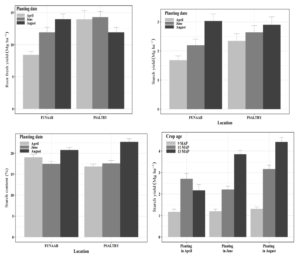
Figure 1: Effects of location and planting date on cassava fresh root yield, starch content and yield.
The crop age × planting date interaction was such that the fresh root yield of cassava harvested at 9 and 13 MAP increased from the April planting to the June planting but decreased towards the August planting (Figure 2). When harvested at 11 MAP this was inversed with lowest fresh root yields when planted in June. Cassava planted in April had the largest yield increase when the harvest was delayed from 9 to 11 MAP, with a marginal increase from 11 to 13 MAP. June planted cassava fresh root yields increased the strongest from 11 to 13 MAP. Fresh root yield in August planted cassava increased the strongest from 9 to 11 MAP. Root starch contents increased in June and August planted cassava consistently with increasing crop age at harvest. April planted cassava had highest starch contents at 11 and lowest at 13 MAP. The interaction on the starch yield was such that the planting month did not affect the starch yield, when harvested at 9 MAP. In June and August-planted cassava starch yields increased with increasing crop age at harvest. In April planted cassava, the highest starch yield was attained at 11 MAP.
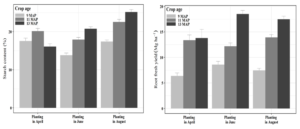
Figure 2: Effects of planting date and crop age on cassava fresh root yield, starch content and starch yield.
The planting date × fertilizer interaction on fresh root and starch yield was such that the largest yield increment was attained with fertilizer application to April planted cassava, which was more than twice as high as in later planted cassava (Table 5). The lowest increments were found in June planted cassava. Effects on starch yield were 2 to 4 times larger than effects on fresh root yields. date (Mg ha-1) (Mg ha-1)
Planting
Control
Fertilizer
Difference
Absolute
Relative (%)
Fresh root yield
April
8.62bB
13.76aA
5.14
+59.6
June
11.94aB
14.27aA
2.32
+19.4
August
11.59aB
14.31aA
2.73
+23.5
Starch yield
April
1.30cB
2.73bA
1.43
+143.3
June
1.96bB
2.88bA
0.92
+91.6
August
2.44aB
3.50aA
1.06
+103.1
The location × crop age at harvest interaction (Table 6) on fresh root and starch yield was such that cassava harvested at 9 MAP produced lower fresh root and starch yields at Psaltry than at FUNAAB. However, when cassava was harvested at 11 and at 13 MAP the fresh root and starch yields were higher at Psaltry and the differences between sites were larger at the later harvests than at 9 MAP.
The crop age at harvest × fertilizer interaction (Table 7) on fresh root and starch yield was such that when harvested at 11 and 13 MAP the root yield increases due to fertilizer application were slightly more than twice as high as when harvested at 9 MAP. However, the relative increases were similar at 9 and 13 MAP. Relative increases of the starch yield were about twice as high as the fresh root yield increases. Absolute starch yield increases were close to three times higher when harvested at 11 or 13 MAP compared with harvesting at 9 MAP. harvest (MAP) (Mg ha-1) (Mg ha-1)
Crop age at harvest (MAP)
FUNAAB
Psaltry
Difference
Absolute
Relative (%)
Fresh root yield (Mg ha-1)
9
7.99cA
6.99cA
-1.00
-12.5
11
12.11bB
14.22bA
2.11
+17.4
13
14.23aB
18.95aA
4.72
+33.2
Starch yield (Mg ha-1)
9
1.32cA
1.13cB
-0.19
-14.3
11
2.50bB
2.89bA
0.39
+15.6
13
3.09aB
3.87aA
0.78
+25.0
Crop age at
Difference
Control
Fertilizer
Absolute
Relative (%)
Fresh root yield
9
6.56cB
8.41cA
1.85
+28.2
11
11.12bB
15.21bA
4.09
+36.8
13
14.47aB
18.71aA
4.24
+29.3
Starch yield
9
0.93cB
1.52cA
0.59
+63.9
11
1.99bB
3.40bA
1.41
+71.0
13
2.78aB
4.18aA
1.40
+50.5
Three-way interaction of location × planting date × crop age at harvest.
The location × planting date × crop age at harvest interaction revealed three different root yield responses at the two locations to the planting date (Figure 3). Least consistent was the root yield response at FUNAAB when planted in April. Generally, root yields increased with longer cropping phases except for the harvest of April planted cassava at 13 MAP at FUNAAB, which attained a lower yield than the harvest at 11 MAP. June planted cassava produced higher yields at Psaltry than at FUNAAB, at all harvest ages, while August planted cassava produced higher yields at FUNAAB than at Psaltry. Highest root yields were attained at Psaltry when planted in April and harvested at 13 MAP. At FUNAAB highest root yields were attained when planted in June and August and harvested at 13 MAP, with a marginal difference between the planting dates.
The location × planting date × crop age at harvest interaction of the starch concentration in the roots was such that when planted in June, starch concentration increased with increasing crop age at harvest but did not differ between locations (Figure 4). When planted in August, starch concentrations increased as well with increasing crop age at harvest yet were higher at Psaltry than FUNAAB, when harvested at 11 and at 13 MAP. The patterns of changes of the starch concentration in April planted cassava did not resemble those of June and August planted crops. At FUNAAB starch concentration increased from 9 to 11 MAP harvest age and decreased to 13 MAP being at the same level as at 9 MAP. At Psaltry starch concentration was the same at 9 and 11 MAP and decreased to 13 MAP.
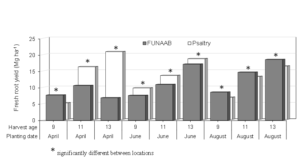
Figure 3: Cassava fresh root yields by location, planting date and crop age at harvest.
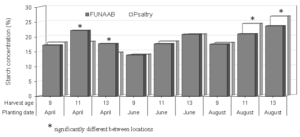
Figure 4: Starch concentration in cassava roots by location, planting date and crop age at harvest.
The starch yields (Figure 5) had similar responses to location, planting date and crop age at harvest as the fresh root yields. At FUNAAB the inconsistent starch yield response to 13 MAP crop age at harvest, when planted in April, was as in the fresh root yield with the lowest starch yields produced. June planted cassava had the same starch yield response as in the root yield. In August planted cassava the higher starch contents at Psaltry in roots harvested at 11 and 13 MAP, could compensate for the lower root yields resulting in no starch yield differences between locations.
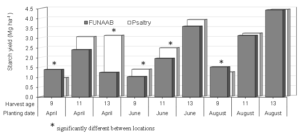
Figure 5: Cassava root starch yields by location, planting date and crop age at harvest.
Four-way interaction
The cassava fresh root and starch yield had a highly significant (P<0.01) location × planting date × crop age × fertilizer interaction (Table 2). Except for the cassava planted in June, harvested at 9 MAP at FUNAAB, all treatments had a positive root yield response to fertilizer application (Figure 6). The patterns of the responses were generally such that with increasing crop age at harvest the fresh root yield increased except for the cassava planted in April at FUNAAB, which produced highest root yields when harvested at 11 MAP and planted in April. Root yield increases were higher in cassava planted in April than at the later planting dates, with a higher increment at Psaltry than at FUNAAB. The effect on the starch yield was similar. Fresh root yield increases due to fertilizer application were smallest when cassava was harvested at 9 MAP and more than twice as high when harvested at 11 and 13 MAP. Consequently, highest root yield increments were in early planted, yet late harvested cassava.
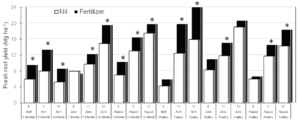
Figure 6: Fresh cassava root yields by fertilizer application, location, planting date and crop age at harvest. * Significant difference between Nil and Fertilizer.
The fresh root yield gains due to fertilizer application (Figure 7) show the superior responses of April planted and late (11 and 13 MAP) planted cassava at Psaltry. The response of the starch yield to fertilizer application (not shown) was similar to that of the fresh root yield. However, fertilizer had a positive impact of starch yield in all treatments and the impact was relatively higher than the impact on the fresh root yield.
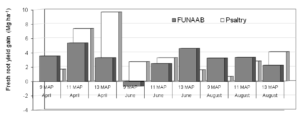
Figure 7: Fresh root yield increases due to fertilizer application at FUNAAB and Psaltry, by planting date and crop age at harvest.
Root growth rates
Due to the different length of growth the root and starch yields may be caused simply by the longer time to grow or the conditions the crops were exposed to. The average monthly growth rates were highly variable between locations planting dates and crop ages at harvest (Figure 8). At Psaltry, monthly growth rates increased with crop age at harvest in all planting dates, albeit large differences in the increments between the crop ages at harvest. At FUNAAB, growth rates of June and August planted cassava followed the same trend as at Psaltry with increasing growth rates with increasing crop age. Only the April planted cassava harvested at 13 MAP had a drop in growth rates compared with those of cassava harvested earlier.
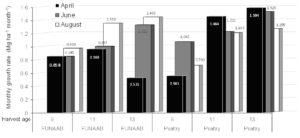
Figure 8: Monthly cassava root mass growth rates by location, crop age at harvest and planting dates.
Discussion
Cassava cultivated by Nigerian farmers is usually rain fed due to the lack of irrigation facilities. This leads to a peak in planting after the start of rains in March and fewer fields being planted towards the end of the rainy season. Thus, the planting periods in this study (Table 1) were scheduled from the onset (March/April) to the middle (June/July) and to the end of the rainy season (August/September). Traditionally, farmers allow cassava to stay longer than 12 months on the field before harvesting, irrespective of the variety. This practice may be the consequence of harvesting over longer phases in former times, possibly due to the lack of marketing opportunities and the low capacity of the artisanal cassava processing facilities (Ngeve, 2003). However, today many of the improved varieties do not tolerate staying longer on the field and may be at risk of root rot and other yield reducing processes (Enesi et al., 2022a). However, in this study the choice of an older variety (TMS 30572) and a modern variety (TME 419) did not show significant effects or interactions between variety and crop age at harvest. Nevertheless, the yield reductions at FUNAAB when planted in April and retained for 13 months on the field may stem from root losses due to rot but can as well be a consequence of the rains recommencing after the dry season and causing a remobilization of starch from roots to establish a new canopy. Similar root yield declines were observed by Enesi et al. (2022b) when the harvest was conducted shortly after the start of the rainy season.
Therefore, our attempt to determine the effect on root yields by harvesting cassava earlier than 12 MAP shows that, depending on the rainfall conditions just before the harvest, a shortening of the crop duration may be an advantage. Such positive effects of earlier harvest are however restricted to situations when rains had fallen over a long phase before the harvest. Harvesting short after recommencing rains that triggered the formation of a new canopy, is not recommended. The general trend of higher root and starch yields with increasing crop age at harvest calls for a detailed analysis of the opportunity costs of longer land occupation by cassava versus alternative land use by following crops.
The planting date and crop age at harvest affected the fresh root yield, starch content and starch yield with higher values obtained when planted in June and August than when planted in April. Similar results were obtained by Mahakosee et al. (2019), who reported that variation in root yields was dependent on the planting date and time of harvest. Sriroth et al. (2000) and Janket et al. (2018) reported that higher starch contents and starch yields were obtained when cassava was planted late, either towards or at the end of the rainy season. The variation in the root yields is dependent on the environmental conditions, especially rainfall and temperature (Benesi et al., 2008). The consistent favorable rainfall and temperature after initial water deficit experienced by late planted cassava favors high root yields compared with early planted cassava that experienced water deficit late in the growth period. The highest biomass production rates are attained by cassava between 6 and 12 MAP. Therefore, crops that established just before the dry season would receive under south-western Nigerian conditions up to 7 months of continuous rain after the dry season and would thus have the longest possible phase of uninterrupted growth, which would lead to increased root yields, starch contents and thus starch yields (Alves, 2002; Mahakosee et al. 2019). However, for late planted cassava to be successful, rainfall around the planting time or the stored soil moisture must be adequate to support the establishment of the crop before the onset of dry season (Puangbut et al., 2015) and this must be considered by farmers when planting cassava late.
Increasing the crop age to 13 MAP resulted in higher fresh root yields, starch content and starch yields than when harvested at 9 and 11 MAP, except for the April planted cassava at FUNAAB. The higher root yields attained at 13 MAP than at 9 MAP can be attributed to the longer growing phase, as long as such added time fell into the rainy season. However, looking at the root biomass production rate of the different treatments shows that with increased crop age at harvest the growth rates increased This was also supported by Gnamien et al. (2020) and Micheal et al. (2015). Rainfall variation from rainy to dry season is an important factor which influences cassava productivity (Sriroth, et al., 2000; Aina et al., 2007). The reduction in the starch content for 13 month harvesting period after an initial increase from 9 to 11 MAP when planted in April supports the notion of losing root mass and starch when the crop recovers after a phase of water deficiency. Cassava mobilizes stored starch from the roots to rapidly produce new leaves and green stems after the dry season (Santisopasri et al., 2001). Our study shows that the onset of rains after the dry season caused a reduction in starch content at 13 MAP for April plantings. Defloor et al. (1998) and Ceballos et al. (2011) reported a high translocation of stored assimilates from the roots to the shoots following increased water availability after a period of water stress, thereby causing a reduced dry matter and starch content.
The larger increase in root yield at FUNAAB than at Psaltry in August planted cassava can be ascribed to a higher capacity of the soil to hold water to support the initial cassava growth before and into the dry season due to the higher clay and organic matter content of the soil at FUNAAB, reducing the initial water stress during the early growth and root bulking initiation. On the other hand, higher root yields observed at Psaltry when planted in April and June can be the result of the favorable soil condition (higher sand percentage), while receiving adequate amounts of rain. Enesi et al. (2022a) observed higher root dry matter yields at locations with predominant porous sandy soils, probably promoting the ability of cassava roots to penetrate the soil and reduced root losses during harvest due to breakage. The reduction of the cassava root yield at the 13 MAP harvest date was caused by root rot and rodent attack as observed during the harvest. Soils with high clay content appear to provide more frequently conditions leading to root rot, likely caused by high moisture content and poor aeration (Ghuman and Lal, 1982).
Currently small holder farmers in Nigeria and in other Sub-Saharan African countries add little or no fertilizer to cassava because it grows and produces some root yield in poor soil, compared to other crops (Imas and John 2013). Odedina et al. (2012) reported higher leaf biomass of cassava with the application of inorganic fertilizer which could contribute to higher root yield, starch content and starch yield as observed in this study. Olojugba (2018) highlighted that the peak of rainfall between June and September in southwest Nigeria is accompanied with high mineralization rates of soil nutrients compared to mineralization at the onset of rains in April. Such higher availability of soil nutrients to the crop when planted late coupled with sufficient moisture could improve the nutrient uptake by crop roots, thereby contributing to the lower root yield response to fertilizer application of June and August planted cassava.
Conclusion
The fresh root yield, starch content and starch yield were affected by the planting dates and the crop age at harvest. Planting cassava in June and August resulted in higher fresh root yield, starch content and starch yield than when planted in April. Harvesting at 13 MAP produced higher fresh root yields, starch contents and starch yields across the planting periods. The application of inorganic fertilizer resulted in higher root yields, starch contents and starch yields. The lack of differences between the varieties remains a surprise, yet this could be a site-specific response.
For farmers to adopt the results of this study, the economic aspects of fertilizer application and the prolonged occupation of the land by the crop need to be considered. As such the suitability of the investigated measures to increase farmers’ income require a full costing of the fertilizer and the opportunity costs of leaving the cassava longer in the field. However, due to the fluctuations in sales prices of fresh roots over the year the study does provide useful information on suitable planting dates to have a crop ready for harvest at phases of low supply and high prices.
Declaration of Conflict of Interest: The authors declare no conflict of interest.
Acknowledgments
The study was conducted within the African Cassava Agronomy Initiative (ACAI). This work was supported, in whole or in part, by the Bill & Melinda Gates Foundation [OPP1130649]. Under the grant conditions of the Foundation, a Creative Commons Attribution 4.0 Generic License has already been assigned to the Author Accepted Manuscript version that might arise from this submission. The authors thank IITA and BMGF for the support.
References
- Abotbina, S.M. Sapuan, R.A. Ilyas, M.T.H. Sultan, M.F.M. Alkbir, S. Sulaiman, M.M. Harussani, E. Bayraktar, Recent developments in cassava (Manihot esculenta) based biocomposites and their potential industrial applications: A comprehensive review, Materials, 15(19) (2022) 6992.
- G. Adiele, A.G.T. Schut, R.P.M. van den Beuken, K.S. Ezui, P. Pypers, A.O. Ano, et al. Towards closing cassava yield gap in West Africa: Agronomic efficiency and storage root yield responses to NPK fertilizers, Field Crops Res. 253 (2020) 107820.
- O. Aina, A. Dixon, E. Akinrinde, Effect of soil moisture stress on growth and yield of cassava in Nigeria, Pak. J. Biol. Sci. 10 (2007) 3085-90.
- F. Alarcón, Y.D. Duvfour, Sour cassava starch in Colombia. In: Cassava in the third millennium: modern production, processing, use, and marketing systems, Ospina B., Ceballos, H., Colombia: International Center for Tropical Agriculture (CIAT), Latin American and Caribbean Consortium to Support Cassava Research and Development (CLAYUCA), Technical Centre for Agricultural and Rural Cooperation (CTA), (2012), 496-525.
- A.C. Alves, Cassava botany and physiology. In Hillocks, R. J.; Thresh, J. M. (Eds.), Cassava: Biology, production and utilization. CABI Publishing, (2001), 67-89.
- Ayanlade, M. Radeny, J.F. Morton, T. Muchaba, Rainfall variability and drought characteristics in two agro-climatic zones: An assessment of climate change challenges in Africa, Total Environ. 630 (2018) 728-737.
- Bates, D.; Mächler, M.; Bolker, B.; Walker, S. Fitting Linear Mixed-Effects Models Using lme4, Stat. Softw. 67(1) (2015) 1-4.
- Benesi, M. Labuschagne, A. Dixon, N. Mahungu, Genotype x Enviroment Interaction effects on native cassava starch quality and potential for starch use in the commercial sector, African J. Crop Sci. 12 (3) (2004) 205-216.
- R.M. Benesi, M.T. Labuschagne, L. Herselman, N.M. Mahungu, J.K. Saka, The effect of genotype, location and season on cassava starch Extraction, Euphytica. 160 (1) (2008)59-74.
- Busari, F.K. Salako, Effect of tillage and poultry manure application on soil infiltration rate and maize root growth in a sandy Alfisol, Agro-Sci. 11(2) (2013) 24-31.
- Ceballos, J. Ramirez, A.C. Bellotti, A. Jarvis, E. Alvarez, In crop adaptation to climate change; Yadav, S.S.; Redden, R.J.; Hatfield, J.L.; Lotze-Campen, H.; Hall, A.E. Wiley: New York, NY, USA, (2011), 411-425.
- CIAT: Centro Internacional de Agricultura, Annual Report 1987-1991. Working Document, 116, (1992),
- Charles, K. Sriroth, T. Huang, Proximate composition, mineral contents, hydrogen cyanide and phytic acid of five cassava genotypes, Food Chem. 92(4) (2005) 615-620.
- CHIRPS: Climate Hazards Group Infrared Precipitation with Station Data, Serv. Clim. Available online: https://climateserv.servirglobal.net/ (Accessed 1 April.2021).
- F. Chua, L. Youbee, S. Oudthachit, P. Khanthavong, E.J. Veneklaas, A.I. Malik, Potassium fertilisation is required to sustain cassava yield and soil fertility, Agronomy. 10 (8) (2020) 1103.
- Defloor, R. Swennen, M. Bokanga, J.A. Delcour, Moisture stress during growth affects the breadmaking and gelatinisation properties of cassava (Manihot Esculenta Crantz) flour, Sci. Food Agric. 76(2) (1998) 233-238.
- T. Denton, I.I. Azogu, M.K. Ukoll, Cassava based recipes for household utilization and income generation, (2004), Federal Department of Agriculture, Abuja, Nigeria.
- O. Enesi, S. Hauser, P. Pypers, P.; Kreye, C.; Tariku, M.; Six, J. Understanding changes in cassava root dry matter yield by different planting dates, crop ages at harvest, fertilizer application and varieties, Eur. J. Agron. 133 (2022a) 126448.
- O. Enesi, P. Pypers, C. Kreye, M. Tariku, J. Six, S. Hauser, Effects of expanding cassava planting and harvesting windows on root yield, starch content and revenue in Southwestern Nigeria, Field Crops Res. 286 (2022b) 108639.
- A. Fagbami, G.A. Akinbola, Reference soil of the Southern guinea savanna Region of cenral-western Nigeria (Oyo state). International Soil reference and Information Centre. Soil Brief Nigeria. 8 (1995) 5.
- FAOSTAT: Food and Agriculture Organization of the United Nations. Avaialable online: http://www.fao.org/faostat/en/#data/QA (Accessed 15 April 2020).
- S. Ghuman, R. Lal, Growth and plant-water relations of Sweet Potato (Ipomea Batata) as affected by soil moisture regimes, Plant Soil. 70 (1) (1983) 95-106.
- C.A. Gnamien, A.K. Martial-Didier, D.K. Martin, T. Messou, T.B.F. Honora, T. Kablan, Effect of harvest date on technological yield and evolution of hydrocyanic acid loss rate after transformation of cassava root (Manihot Esculenta CRANTZ) from Yacé variety by Placali and Attiéké Consumed in Côte d’Ivoire, IJASRE 06 (01) (2020) 147-155.
- S. Ikuemonisan, T.E. Mafimisebi, I. Ajibefun, K. Adenegan, Cassava production in Nigeria: trends, instability and decomposition analysis (1970-2018), Heliyon. 6 (10) (2020) e05089.
- Imas, K.S. John, Potassium Nutrition of Cassava. International Potash Institute, 34 (2013)13-18.
- Janket, N. Vorasoot, B. Toomsan, W. Kaewpradit, P. Banterng, T. Kesmala, P. Theerakulpisut, S. Jogloy, Seasonal variation in starch accumulation and starch granule size in cassava genotypes in a tropical savanna climate, Agronomy. 8 (12) (2018) 297.
- Kaluba, S.Mwamba, D.P. Moualeu-Ngangue, M. Chiona, K. Munyinda, E. Winter, H. Stützel, B.H. Chishala, Cropping practices and effects on soil nutrient adequacy levels and cassava yield of smallholder farmers in Northern Zambia, Int. J. Agron. (2021) 1-12.
- Kaur, P. H. Ahluwalia, Singh, Cassava: extraction of starch and utilization of flour in bakery products, Jour. of Food and Ferm. Tech. 6 (2) (2016) 351.
- E. Kleinkopf, D.T. Westermann, M.J. Wille, G.D. Kleinschmidt, Specific gravity of russet burbank potatoes. Am. Potato J. 64 (11) (1987) 579-587.
- Knutsson, Long-term storage of starch potato and its effect on starch yield. M.Sc. thesis. Swedish University of Agricultural Sciences. 2012. Available at: http://stud.epsilon.slu.se/4996/1/knutsson_j_121023.pdf. (Accessed in September 2021).
- O. Kolawole, L. Agbetoye, S.A. Ogunlowo, Sustaining World food security with improved cassava processing technology: The Nigeria experience. Sustainability, 2 (12) (2010) 3681-3694.
- V. Lenth, Emmeans: estimate marginal means, aka least-squares means, R package version 1.7.2. Available: https://CRAN.R-project.org/package=emmeans. (Accessed 22 September 2022).
- Mahakosee, S.Jogloy,; N. Vorasoot, P. Theerakulpisut, P. Banterng, et al. Seasonal variations in canopy size and yield of Rayong 9 cassava genotype under rainfed and irrigated conditions, Agronomy. 9 (7) (2019) 362.
- Michael, H. Edet, Tijani-Eniola, S.T.O. Lagoke, T. Gbassay, Relationship of cassava growth parameters with yield, yield related components and harvest time in Ibadan, Southwestern Nigeria. Nat. Sci. Res. 5 (2015) 87-92. ISSN 2224-3186 (Paper) ISSN 2225-0921 (Online).
- M. Ngeve, Cassava root yields and culinary qualities as affected by harvest age and test environment, J. Sci. Food Agric. 83 (4) (2003) 249-257.
- Odedina, S. Ojeniyi, S. Odedina, Integrated nutrient management for sustainable cassava production in South Western Nigeria, Arch. Agron. Soil Sci. 58 (2012) S132-S140.
- R. Olojugba, Effects of rainfall seasonal dynamics on the chemical properties of the soil of a tropical southern humid rainforest ecosystem in Nigeria, IJPSS. 23 (5) (2018) 1-11.
- M. Omodamiro, M.O. Iwe, U.J. Ukpabi, Pasting and functional properties of lafun and starch processed from some improved cassava genotypes in Nigeria, Nig. Fd. J. 2007; 25 (2).
- O. Onasanya, S. Hauser, M. Necpalova, F.K. Salako, C. Kreye, M. Tariku, J. Six, P. Pypers, On-farm assessment of cassava root yield response to tillage, plant density, weed control and fertilizer application in Southwestern Nigeria, Field Crops Res. 262 (2021) 108038.
- Y. Parkes, D.F.K. Allotey, E. Lotsu, E.A. Akuffo, yield performance of five cassava genotypes under different fertilizer rates. Int. J. Agric. Sci. 2(5) (2012) 173-177.
- H. Pervaiz, J. Iqbal, Q. Zhang, D.Chen, H. Wei, M. Saleem, Continuous cropping alters multiple biotic and abiotic indicators of soil health, Soil Syst. 4 (4) (2020) 59.
- Puangbut, S. Jogloy, N. Vorasoot, A. Patanothai, Responses of growth, physiological traits and tuber yield in helianthus tuberosus to seasonal variations under tropical area, Sci. Hortic. 195 (2015) 108-115.
- R Core Team, R: A language and environment for statistical computing. Vienna, Austria: R Foundation for Statistical Computing, 2022.
- K. Salako, P.O. Dada, C.O. Adejuyigbe, M.O. Adedire, O.Martins, C.A. Akwuebu, O.E. Williams, Soil strength and maize yield after topsoil removal and application of nutrient amendments on a gravelly Alfisol toposequence, Soil Tillage Res. 94 (1) (2007) 21-35.
- Santisopasri, K. Kurotjanawong, S. Chotineeranat, K. Piyachomkwan, K. Sriroth, C.G. Oates, Impact of water stress on yield and quality of cassava starch, Ind. Crops Prod. 13 (2) (2001) 115-129.
- G. Santo, J. Sarkodie-Addo, Performance of Cassava (Manihot Esculenta Crantz) varieties under different soil amendments, JEAI. (2019) 1-7.
- Sriroth, K. Piyachomkwan, S. Wanlapatit, C.G. Oates, Cassava starch technology: The Thai Experience, Euphytica. 120 (1) (2000) 95-102.
- J. Tonukari, Cassava and the future of starch, Electron. J. Biotechnol. 7 (1) (2004) 1-4.
- D. Uchechukwu-Agua, O.J. Caleb, U.L. Opara, Postharvest handling and storage of fresh cassava root and products: A Review. Food Bioprocess Technol. 8 (4) (2015) 729-748.
- Von Scheele, G. Svensson, J. Rasmusson, Determination of the starch content and dry matter of potatoes with the aid of specific gravity, [in German] Land wirtsch. Vers. Stn. 127 (1937) 67-96.
- H. Wickham, Ggplot2: Elegant Graphics for Data Analysis, 2nd ed. Use R!; Springer International Publishing : Imprint: Springer: Cham. (2016).